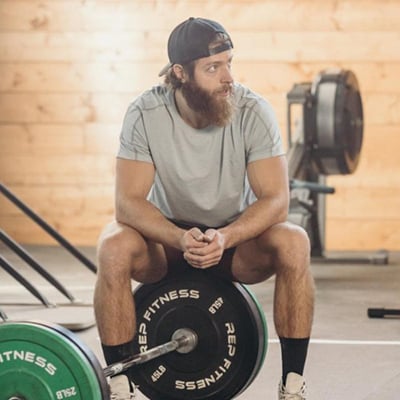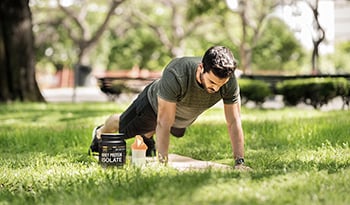A Strength Coach Shares Tips to Optimize Bodyweight Workouts

There are a lot of different ways to exercise if you want to gain more muscle and get stronger. One of the most popular ways to train is with one’s own body weight. In fact, bodyweight workouts are how a lot of us got into training in the first place. Who didn’t do push-ups and sit-ups in PE class growing up? We didn’t know it at the time, but we were technically doing bodyweight workouts.
There is a lot to like about bodyweight workouts. First, they’re completely free. You don’t need a gym membership or fancy gear to move your own bodyweight. Second, they’re great for everyone and not just “beginners.” Third, they’re easy to scale to promote continuous growth—you just have to be creative.
In this article, we’re going to discuss four ways to modify bodyweight workouts to make them more fruitful for your strength, body composition, and all-around fitness. We’ll also touch on some nutritional advice to support your training.
Are Bodyweight Workouts Worth It?
Before we dive into the logistics of how to make bodyweight workouts harder, let’s first address a common misconception—that bodyweight workouts are only for beginners and cannot produce adequate gains. This idea is completely unfounded.
The misconception circles around the idea that bodyweight workouts are not as effective as weight training because you cannot load bodyweight exercises as heavy. While that’s obviously true, this logic misses the bigger picture—that there are more elements to training than simply getting stronger.
There are different forms of strength, so while bodyweight workouts might not necessarily be the best bet for improving 1-rep maxes, they can be phenomenal for improving muscular endurance and power production. In addition, they can be great for increasing time under tension, which can lead to hypertrophy and improving on other skill-based training elements like stability, balance, and coordination.
Don’t sell bodyweight workouts short. If they don’t feel “tough” enough for you, that’s simply because you have a higher training threshold. Exercises will need to be modified to increase bodyweight workout difficulty. Simply moving through reps is not an effective way to bodyweight train for a long duration.
4 Ways to Optimize Bodyweight Workouts for Strength and Size
To improve strength and muscular hypertrophy with bodyweight workouts, there are a few easy modifications you can apply.
Play With Tempo
A set tempo for exercises is a great way to increase total time under tension for targeted muscle groups. This entails applying a goal-oriented time to exercises, then maintaining these times to accrue more time under tension. By increasing total time under tension, we can exhaust muscles and create a higher ask on muscle fibers, which can increase hypertrophy.
To apply tempo to exercises, use the following four number scheme to create time-oriented goals for movement patterns. An example would be:
Tempo: 4110
- 4-second eccentric/lowering portion
- 1-second pause at the bottom
- 1-second concentric/lifting portion
- 0-second hold at the top
For a hypertrophy focus, add more eccentric and concentric seconds, and for strength play around with pauses and holds.
Use 1.5 reps
In addition to tempo, 1.5 reps are another fantastic tool for improving strength and time under tension. A 1.5 rep exercise involves performing a full rep, then a half rep, and counting both of those as a single rep.
For example, for a push-up, you would lower normally, then do a half-rep up stopping shy of lockout, then lower back down and press all the way through to the top, and count that as a single 1.5 rep. You could also do a half-rep to begin the rep scheme. So for example, a bodyweight squat would start with a normal descent, then you’d stop halfway down, return to a standing position, then perform a full range of motion squat and count that as a 1.5 rep.
Bodyweight Workouts for Power
Bodyweight workouts are awesome for improving power output. The exercises required are low impact and can be performed with little-to-no risk for injury since they can be easily scaled. For example, you can dictate how high you jump in a squat jump, so you limit your risk of injury by only performing what you're comfortable with.
To improve power with bodyweight workouts simply add an element where you’re forcefully moving the body away from its point of contact (the ground). In the push-up, you would push the upper body off the ground where the hands would then be floating. For the squat and lunge, you would jump upwards to bring the feet off the ground.
To increase the difficulty for power-focused bodyweight exercises, control the eccentric and slow it down to a dead pause, then add a fast contraction. For example, in the squat jump, lower yourself slowly and pause, demonstrating you have control, then explode upwards and forcefully drive the quads through the ground.
Bodyweight Workouts for Endurance
Outside of just adding more reps, how else can we improve muscular endurance with bodyweight workouts? Two fantastic ways for increasing muscular endurance with bodyweight workouts are as follows.
First, make combo moves. To make a combo move, you’ll simply combine two or more exercises into one. These are similar to circuit training in that you’re performing exercises right after one another with strategy and intent, but they vary just slightly. For a combo move, one full rep is the completion of one rep for each designated exercise.
So if you did a squat, push-up, and lunge, then you would do one rep of each and that would then count as a full rep. This type of work is great because it gives you a lower total rep goal.
Second, make a time-oriented goal. This modification is relatively simple. Instead of focusing on reps, direct your attention towards a time. To improve endurance, we need to increase the capacity of what we can do.
Let’s say we want to increase our lower body muscular endurance and we’ve decided we want to perform squats and lunges to do so. Normally, we’d place a rep goal with rest times and so forth, but for a time-oriented goal, we’re going to focus on simply moving and executing these exercises the whole time taking limited rest times. So if the goal is 15-minutes, you would perform 1 squat, 1 lunge, and continue steadily moving, only taking a rest when you absolutely need it.
4 Nutrition Tips for Bodyweight Workouts
Since bodyweight workouts are effective tools for improving fitness, strength, and body composition for a vast majority of the fitness enthusiast population, then we need to consider how nutrition will be similar to normal training.
Instead of creating a bias towards how we view nutrition pre- and post-workout, we need to remind ourselves that we still need ample recovery and fuel to properly progress. This is a trap that many can fall into due to the mindset towards bodyweight workouts, thinking “They’re easier, so I can do them more often and my post-workout nutrition doesn’t really matter.”
This logic can create a few problems, so it’s a good idea to keep eating well and fueling the body appropriately. If you find yourself performing periodized bodyweight workouts on a regular basis, then keep these three nutrition tips in mind.
1. Keep It Consistent
It might feel odd at first, but keep your nutrition and eating habits the same as if you were weight training normally. For those just beginning with bodyweight workouts, welcome! Now is a great time to start building good nutritional habits.
The best way to do this is to keep it simple. Eat natural, quality foods, and aim to eat meals that contain a spread of macronutrients.
2. Remember Your Protein
Supplements can also be useful when doing more bodyweight workouts. Just like traditional weight training, protein is important for recovery and growth. If you’re nervous about getting enough protein on a daily basis, then opt for a protein shake that fits into your daily caloric and macronutrient goals.
If you’ve never consumed a protein shake, then a good idea is to use it with breakfast or post-workout. For those that have consumed protein shakes, or do so regularly, continue to use your shakes like normal when doing more bodyweight workouts.
3. Consider Creatine
Creatine is a fantastic supplement for improving strength, endurance, and power. Even though bodyweight workouts might not feel as hard as your traditional weight training workouts, it’s still a good idea to consume creatine if your goal is improving overall fitness.
Creatine is easy to consume and is one of the few supplements on the market that has a good amount of research backing up its benefits.
4. BCAAs Might Be Worth Considering
If you're looking for additional amino acids in your diet and want a flavored drink that provides the body with more essential amino acids while potentially staving off hunger, then BCAAs, or branched-chain amino acids, might be worth considering. These products can be useful for increasing total leucine intake, which is an amino acid that is suggested to play a role in muscle protein synthesis.
Note: As always, it’s a good idea to first consult your primary medical provider before starting any new exercise, nutrition, or supplement regimen!
Bodyweight workouts are an effective way to increase strength, power, endurance, and overall fitness. Instead of viewing them as only being useful for beginners, try getting creative and really pushing their level of difficulty to increase your gains. Treat them like normal training and place emphasis on fueling the body and recovery properly.
PENAFIAN:Hab Kesejahteraan ini tidak berhasrat untuk memberikan diagnosis...













































































 Kandungan
Kandungan














